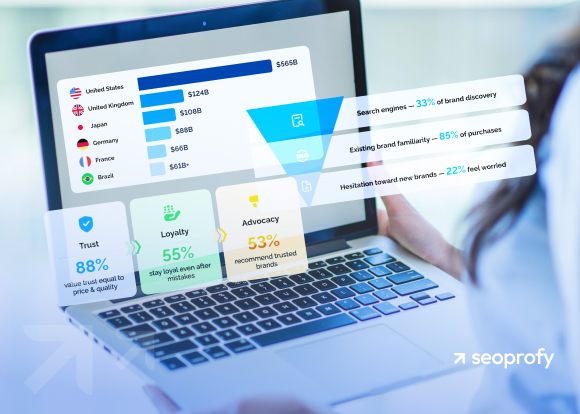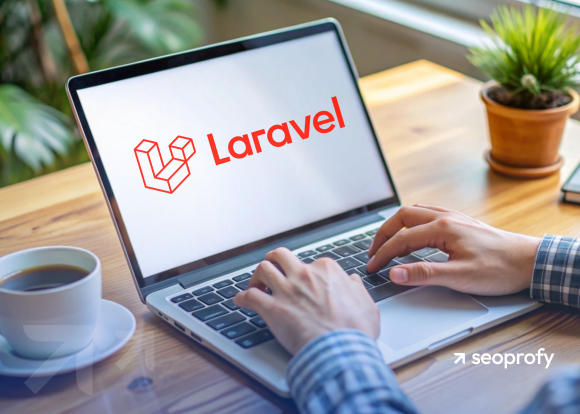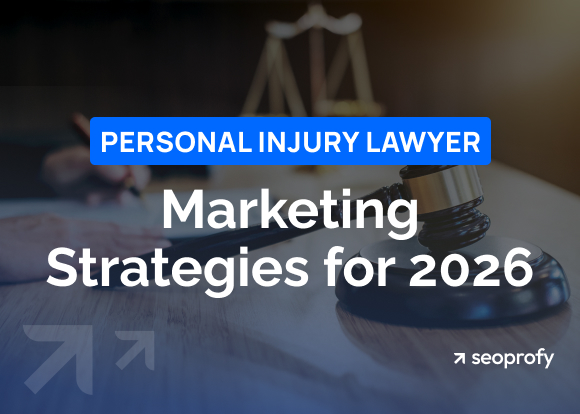Retail SEO (Search Engine Optimization) is a strategy implemented to help retailers boost their visibility in search engine results pages (SERPs). It involves improving the site’s structure, content, backlink profile, and other elements to rank higher for relevant keywords, ultimately leading to increased sales and organic traffic.
Nonetheless, implementing certain SEO techniques remains highly challenging for online retailers, as they must optimize hundreds or even thousands of product pages. So, is it possible to achieve high search result rankings in this niche? We’ve prepared a set of useful SEO tips for retail shops to help you boost your online presence, outperform your competitors, and expand your customer base.
- 88% of users are less likely to return to the online store after a bad experience.
- The core elements of a successful retail site include mobile-friendly UX, clear structure, inspiring CTAs, unique content, and a strong backlink profile.
- 76% of modern buyers use their smart devices to make purchases.
- 89% of buyers prefer businesses that respond to all customer reviews.
Why SEO Is Critical for Your Retail Business
If you sell goods online, you’ll never reach your clients without proper SEO for retailers. It’s not enough just to launch a website and wait for crowds of excited customers. You need to regularly update your pages, optimize them, and craft valuable content. SEO for retail shops encompasses all these techniques, as well as numerous other processes aimed at enhancing your business performance.
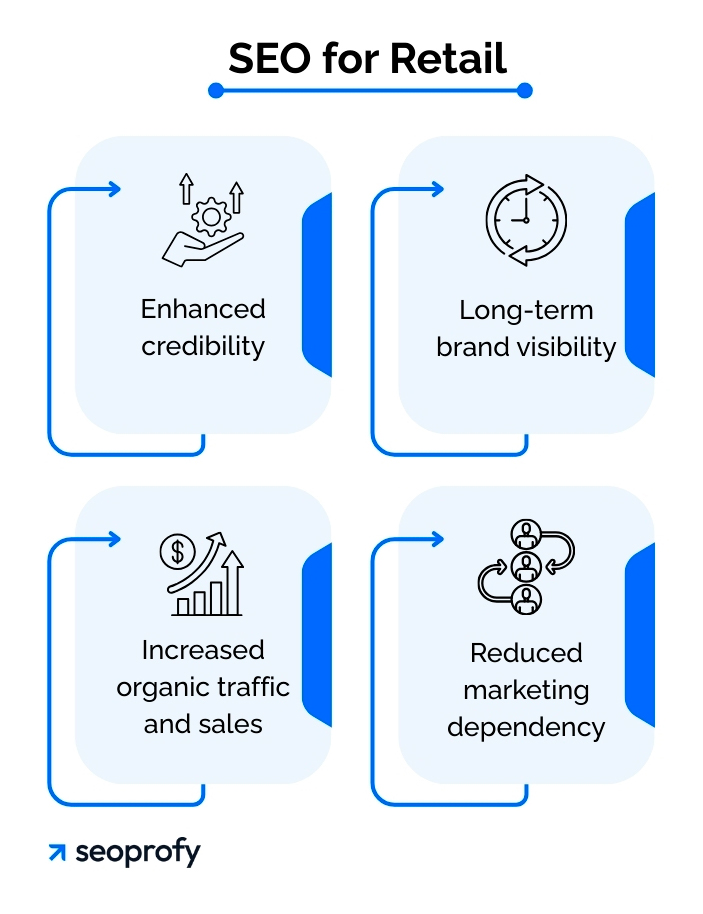
Search engine optimization for online shops takes time and effort. Nevertheless, the benefits of an efficient SEO strategy are undeniable and include:
- Enhanced credibility: Search engine algorithms consider a variety of factors while ranking websites. They opt for sites with high-quality content, a strong backlink profile, and a well-optimized technical background. The right SEO strategy will help your website meet the high-quality standards of modern search engines.
- Long-term brand visibility: According to our ecommerce marketing statistics, 88% of users are less likely to return to the site after a bad experience. On the other hand, an online shop with unique content, intuitive navigation, and positive reviews can help you establish a brand that continues to grow year after year.
- Increased organic traffic and sales: The harsh truth is that only 9% of buyers scroll down to the bottom of the first page of Google. So, if you aren’t on top for your target keywords, you lose thousands or even millions of potential customers.
- Reduced marketing dependency: You can significantly lower marketing costs by implementing search engine optimization. It doesn’t work as fast as paid search, but it’ll bring your business more advantages in the long run. Typically, SEO for retail shops takes at least 4 months, while the budget directly depends on clients’ goals, the site’s condition, and competition. The good news is that after optimization, you’ll simply need to monitor your site’s performance and periodically adapt your strategy.
Do you want to gain all the mentioned benefits without making numerous mistakes while optimizing your website? Opt for our professional eCommerce SEO agency, and our team will take care of your online visibility!
Cornerstones of Retail Search Engine Optimization: On-Site SEO Basics
SEO for retail sites focuses not only on the quality of content but also on technical elements such as website structure and mobile-friendliness. Do your clients leave your online store frustrated because loading web pages takes too long, and searching for a desired product is more challenging than solving a puzzle? Then, you should follow our on-page SEO tips.

Optimize Product and Category Pages
The implementation of a successful retail SEO strategy begins with analyzing and improving your product and category pages. Here are a couple of important elements to consider if you want to enhance user experience and boost rankings:
- Product descriptions: Use SEO tools like Ahrefs and Semrush to identify relevant keywords and naturally incorporate them into the content on your category and product pages. Plus, avoid using the same descriptions for similar products, as duplicate content can significantly impact your SEO.
- Images: Visual elements are vital for product pages, but without proper optimization, they may play a mean trick on your site’s performance. Use only top-quality images that reveal the product’s benefits and help users visualize its design. Additionally, compressing them will significantly reduce page load times.
- Alt text: Include target keywords in the alt texts of all images you use on your site. It’ll help search engine algorithms determine what is depicted in a photo, which will have a positive impact on your rankings.
- CTA buttons: These elements are crucial in SEO for retail shops, as they convert website visitors into buyers. Ensure that your pages include multiple CTA buttons that feature encouraging text.
- URLs: You also need to check whether URLs include relevant keywords, as they are also among the factors that help search bots understand the content of a webpage.
- Meta tags: Implement the terms and phrases you’ve discovered during keyword research into your pages’ metadata and headings (H1, H2, etc.). These HTML elements help search engines summarize the content on your pages, ensuring they display it to the audience interested in your products.
- Testimonials: To convert organic traffic, your webpages should include testimonials that highlight the advantages of the products you’re selling. Providing the audience with strong social proof, such as testimonials, is an integral part of SEO for retail shops.
- Reviews: Encourage your customers to leave feedback on your product pages. It’ll keep the information on your site fresh and allow you to interact with your clients.
Improve Website Structure for Easy Navigation and Crawling
A clear and logical website architecture helps search engine algorithms crawl your site. Eventually, this leads to higher rankings and improved indexing. Plus, structured pages are more appealing to your potential customers and reduce bounce rates.
When implementing SEO for retail stores, pay attention to the so-called “breadcrumb trail.” It can be applied by utilizing HTML and CSS within your website’s CMS. This important element creates a clear navigation path from your homepage to other pages, helping users and search bots understand the webpage’s position within the overall site’s architecture. Thus, visitors can explore your website more effectively:

Finally, you need to carefully weave internal links into your content. This is a great way to connect your blog posts with your “money” pages. For example, if you run a store that sells shoes, it may be a great idea to write an article “Top 10 Sneakers for Runners.” Use it to highlight the benefits of each product and add links leading to them:

Of course, when you run an online store with hundreds or even thousands of pages, creating a clear architecture is much more complicated. And if you don’t want everything to collapse, opt for our affordable SEO services. With years of relevant expertise, we’ll ensure a pleasant journey through numerous web pages for both clients and search engines.
Make Mobile and Speed Optimization
Any modern online store should be perfectly optimized for smartphones and tablets, as 76% of online customers use their portable devices to make purchases. Also, Google uses mobile-first indexing. It means that its algorithms prioritize a site’s mobile version when ranking it. Eventually, you should optimize your website for small-screen devices during your on-page SEO campaign.
Responsive design is an integral part of any mobile-friendly website. It arranges all elements on webpages to fit any type of screen. There are differences between the desktop and mobile versions of the pages with such a design, but in both cases, they should be pleasant and easy to navigate:
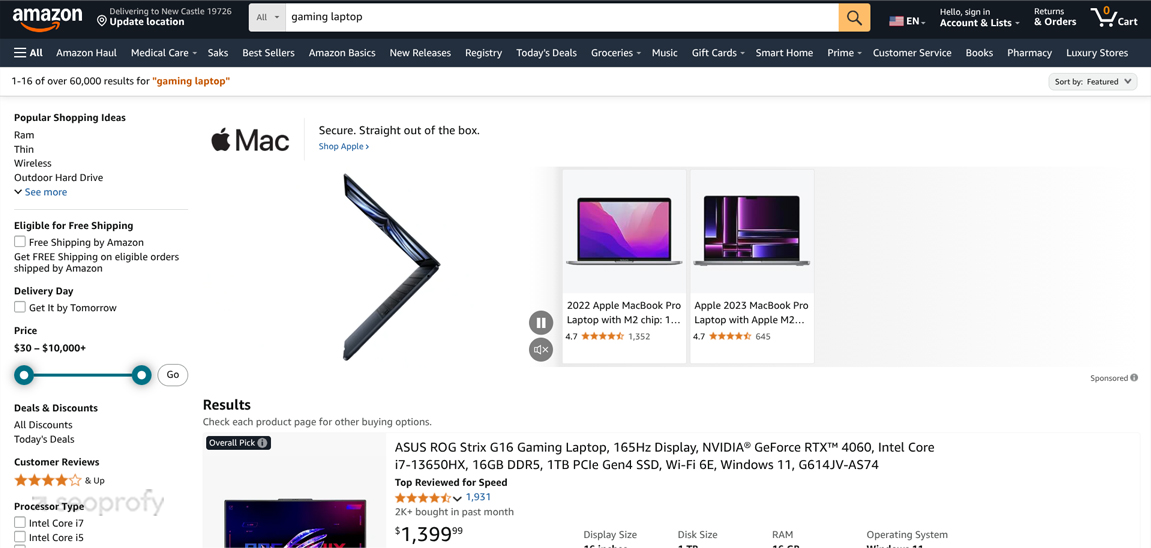

Here are some other tips that will help you boost your retail SEO efforts and improve your site’s responsiveness on all devices:
- Make checkout processes as simple as possible by reducing the number of steps to complete the form.
- Opt for a minimalistic UX design to avoid overwhelming your customers with unnecessary elements.
- Remove pop-ups for mobile users for smoother navigation on the site.
Also, a smart decision for local businesses will be to make phone numbers clickable on smartphones. Although this is a simple decision, it can significantly improve the user experience of potential customers in your area.
The loading speed of your webpages is another essential factor to consider if you want to reach your business and SEO goals. Google recommends using its Lighthouse for estimating your website’s performance on desktop and mobile devices:

This tool will analyze your site, considering different factors, including the loading speed. After that, it’ll provide improvement suggestions, which may include compressing images, optimizing CSS performance, etc.
A high loading speed is crucial for delivering a positive user experience, which is one of the main factors that impact your online visibility and conversions. Therefore, it is essential to regularly check your site’s performance and address any issues as soon as possible.
Leverage Structured Data and Rich Snippets
Search engines use structured data, also known as schema markup, to understand your content. This specific HTML code organizes data on your webpages, making it readable for machines. It’s based on specific vocabulary such as schema.org.
Retail SEO strategies involve leveraging structured data, as it increases CTR, improves visibility in organic search, and boosts the chances of a page appearing in rich snippets. These are the Google Search results with some additional information displayed:

As you can see, rich snippets may include various elements, such as star ratings, prices, and even images. They make your pages more attractive and informative for the target audience, encouraging them to click on your website.
Use Trend Best Practices: Voice and Visual Search Optimization
The rapid development of AI technology has significantly boosted the popularity of voice assistants. Nearly 42% of U.S. residents use them to search for information online. At the same time, many of them opt for voice search to look for products offered by local and online retail businesses.
The best way to make your pages appear in voice search is to optimize their content with long-tail keywords. Also, make sure that the information you provide includes a concise response to the user’s search query. Optimizing your website for a voice search won’t simply boost your retail SEO but also gain a significant advantage. It also opens new business opportunities for you, which are often overlooked by other retailers.
Visual Search is another great way to reach a broader audience. If you want this feature to show your prospective customers the images of your products, consider taking the following steps:
- Change image names: Before uploading the product photo to your website, make sure that its filename includes relevant keywords. For example, instead of “image1.jpeg,” opt for the more descriptive “black-running-shoes-adidas-man.jpeg.” Also, don’t forget to include the keywords in the alt text.
- Use high-quality images: Whether you’re implementing SEO for luxury brands or your homemade products, focus on the quality of your photos. Consider using image formats like JPEG or WebP. They offer an ideal balance between the image size and quality.
- Create image sitemaps: You should create and submit special XML files (image sitemap) to help search engine algorithms discover and index the photos on your pages more efficiently.
Content and Off-Site Strategies to Boost Your Retail SEO
Although a technical background is essential, your online shop still may not provide you with the desired results even if it’s developed by Bill Gates and Mark Zuckerberg. That’s where SEO for retail websites comes into play, focusing on important ranking factors such as content and backlink profile.

Blogging and Content Marketing
Unique, high-quality, engaging content is essential for the successful implementation of SEO for the retail industry. Creating blog posts that include valuable information for your potential clients can boost your conversions and improve E-E-A-T (Experience, Expertise, Authoritativeness, and Trustworthiness) signals. Eventually, Google will show your web pages to a broader audience, boosting your online presence.
So, how can you craft content that not only improves your SEO rankings but also conquers your clients’ hearts, inspiring them to make a purchase? Here are some useful tips to follow:
- Use the right keywords: Focus on long-tail, localized, and intent-driven keywords when creating content for your blog posts and product pages. As a rule, they are easier to rank due to lower competition. Additionally, these keywords attract more qualified traffic to your site. They are often used by users who are ready to make a specific purchase, making it easier to convert them into your clients.
- Know search intent: It’s essential to understand your users’ needs and pain points, so you can craft content that satisfies them. Carefully analyze your competitors’ blogs and popular search engine requests for your main keywords to identify the topics that may interest your audience.
- Provide unique insights: If you want people to share your content, you need to provide extra value. For example, you can conduct research, create attractive infographics, or use other types of visual content that attract references like a magnet.
- Opt for social media: Although social media doesn’t have a direct impact on your rankings, it still drives traffic to your website. Make sure that your content is as easy to share as possible by adding widgets and “Share” buttons. Also, opt for social media marketing and create profiles on platforms that are popular among your target audience to enhance your business’s online presence.
Does your business have both a physical store and an online website? Focus on creating content that is specifically important for your local community. For instance, if your city holds a yearly marathon or festival, you may come up with an article highlighting the best items for these events. A similar logic works for multi-location SEO — craft up-to-date content, considering the slang, interests, and pain points of customers from every location where your brick-and-mortar shops operate.
User-Generated Content and Reviews
The accumulation of positive reviews is a cornerstone of your success in SEO for retail shops. This type of user-generated content allows you to build a connection between your business and your audience. Also, according to our local SEO statistics, 89% of buyers are more likely to choose a business that responds to both positive and negative online reviews.
Additionally, by leaving feedback and posting product photos on your pages, users keep the information on them up to date, which is a positive signal to search engines. The algorithms will see that people spend more time on your website, which will eventually increase its authority.
Also, if you run brick-and-mortar retail sales, you should focus on the development of your Google Business Profile and visibility in local search. Keep the information about your shop in GBP fresh, add high-quality pictures of your products, and respond to customers’ reviews. You may also opt for other local SEO strategies to enhance both your online and offline business processes.
Finally, if you want your eCommerce content strategy to yield the maximum outcomes for your business, consider adding Q&A sections to your product pages. It’ll contribute to E-E-A-T and your overall reputation. Helping your customers to find out more about this or that product will establish trust between you and your website visitors, potentially turning them into loyal clients.
Link Building and Local Partnerships
Many retail shops often operate only in certain locations and aren’t as well-known as popular brands, which makes it difficult for them to rank high for popular keywords. That’s where link building enters the game.
This is an integral part of successful SEO for small businesses, as earning backlinks helps you grow your domain authority. The higher it is, the stronger your chances of reaching the top in search queries for the terms with higher volume, as your site will be more trustworthy in the “eyes” of the algorithms.
Although it may be tempting to buy a few backlinks, such an activity is considered a black-hat technique, which can negatively impact your SEO for a retail website. If you want to avoid Google’s penalties, focus on crafting relevant content with valuable information for your users.
Don’t forget to naturally incorporate local keywords into your blog posts and offer unique industry insights, along with high-quality visuals. In this case, your content won’t just get a stronger chance to rank high and get more website traffic, but also start earning organic backlinks from popular and relevant sites.
Another great way to enhance your backlink profile and reach new clients, while implementing your local SEO strategy, is to get mentioned in business listings. These are the popular websites that include directories of various businesses divided by categories.
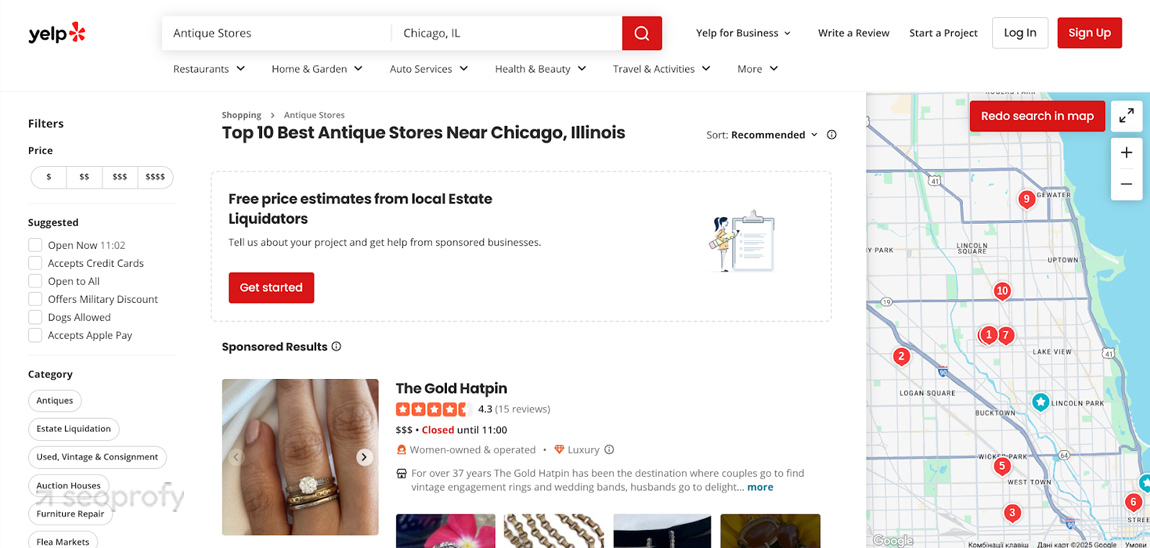
For example, if you run a beauty salon in Chicago, you need to get mentioned by popular local listings such as Yelp, Fresha, and Byrdie. Such a specific niche also calls for specific health and beauty SEO techniques, taking into account the demands of the field.
Develop your business with our custom solutions for SEO in the retail sector. SeoProfy is here to help you reach your goals:
- Increase revenue and online rankings
- Establish a popular brand
- Create an extensive base of loyal customers

Measure and Scale Your SEO Results
Even after implementing an efficient SEO for retail, you need to track the performance of your online store using tools like Google Analytics and Search Console. Consider that search engine optimization trends change from time to time due to regular updates of the algorithms. Plus, it’s crucial to ensure that your current strategy aligns with your industry trends and customers’ needs, which, unfortunately, may also shift over time.
Through regular audits, you can identify any technical issues and pinpoint content that needs to be updated. Remember that it’s easier to fix a problem when it has just occurred rather than waiting until it leads to Google penalties or significant ranking drops.
Unfortunately, online shops often face serious problems after the algorithms’ updates. In this case, you’ll need powerful SEO tools and deep expertise to recover. Instead of wasting your resources and time trying to figure out what works for your site, it’s better to opt for professional help. You’re welcome to get acquainted with our eCommerce SEO pricing and book a free consultation to discuss your project with our experts.
Get More Traffic and Sales with Retail SEO
SEO for retail is a long-term investment that can boost your income, open new business opportunities, and enhance your authority. Combine an excellent technical background with valuable content and a strong backlink profile to take your website to the next level, overcoming your competitors.
And once you need assistance, SeoProfy is always here to lend a helping hand. Together, we’ll go through the digital jungles and accept all the challenges of the search algorithms to make your business thrive.







